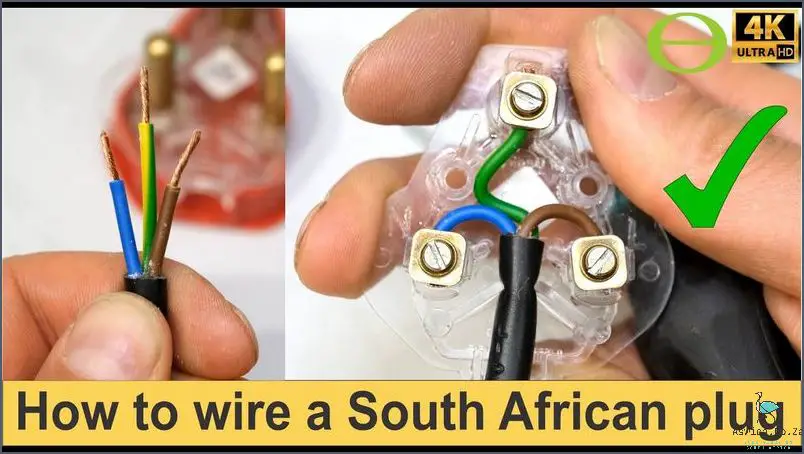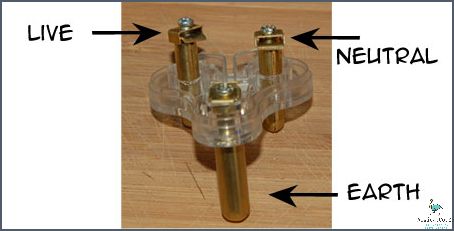
Most plugs in South Africa have three pins – live, earth and neutral. The live wire (usually coloured red or brown) is the one that provides the electricity to the appliance. The earth wire (usually coloured green or yellow) is there for safety in case the live wire comes into contact with anything metal. The neutral wire (usually coloured blue or black) is the one that returns the electricity back to the mains supply.
To wire a plug, you will need a screwdriver, a wire stripper and a pair of pliers. Start by stripping about 15mm of insulation off the end of the live, earth and neutral wires.
Next, take the live wire and insert it into the top left-hand pin of the plug. Do the same with the earth wire into the top right-hand pin, and the neutral wire into the bottom pin.
Once all the wires are in place, screw the pins tightly into the plug. Finally, screw on the plastic cover and make sure it is secure. Your plug is now ready to use!
Contents
How To Wire A Plug In South Africa
To wire a plug in South Africa, start by unscrewing the cover of the plug to access the terminals. Place the cord into the plug and ensure that the line and neutral wires are connected to the correct terminals. The right terminal should be marked with a blue line or an N, while the left terminal should be marked with a brown line or a L. Secure the wires in place by tightening the screws on each terminal. You can then replace the plug cover and test the plug to make sure the connection is secure. Finally, plug the plug into a wall socket and make sure the appliance works correctly.
Safety considerations when wiring a plug

When it comes to wiring a plug in South Africa, safety considerations should be top of mind. There are several factors to consider when wiring a plug, from the type of plug to the voltage and current of the electrical system. Following the proper safety protocols can help avoid potential hazards and ensure safe and efficient operation.
The first step to safely wiring a plug is to understand the type of plug required for the device. In South Africa, the most common type of plug is a ‘Type M’ plug, which is a 15 amp, 250 voltage plug. It is important to use the correct type of plug to ensure that the device is compatible with the electrical system and to prevent any potential hazards. Additionally, it is important to check the device’s manual to determine if any additional wiring is necessary.
Once the correct type of plug has been identified, the next step is to identify the live and neutral wires. Live wires are typically colored red or brown and are used to carry currents, while neutral wires are generally colored black or blue and are used to complete the electrical circuit. To ensure safety, the live wire should always be connected to the live terminal and the neutral wire to the neutral terminal. It is also important to ensure that the wires are properly insulated and not touching any other wires or metallic objects.
Finally, it is important to test the plug before connecting it to the device. To do this, a voltage tester can be used to measure the voltage of the electrical circuit. This can help to identify any potential hazards, such as an overloaded circuit or faulty wiring. If any discrepancies are found, it is important to contact an electrician to ensure that the circuit is safe.
Overall, safety considerations should be taken into account when wiring a plug in South Africa. Following the proper safety protocols can help to ensure that the device is compatible with the electrical system and to prevent any potential hazards. It is also important to test the plug before connecting it to the device to ensure that the circuit is safe. By taking the necessary precautions, wiring a plug can be done safely and efficiently.
What tools and supplies are necessary
Wiring a plug in South Africa is not a task to be taken lightly. The process involves a variety of tools and supplies, which, if not used correctly, can lead to potentially dangerous outcomes. It’s important to have the right tools and supplies for the job, so let’s take a look at what you’ll need to get the job done.

The most important supplies you’ll need are the plug itself, a flat blade screwdriver, a pair of pliers, a voltage tester, and some electrical tape. The plug should be designed for the voltage and current you plan to use, and it should be rated for the type of wiring you’ll be doing. The flat blade screwdriver is for tightening screws, and the pliers are for manipulating the wires. The voltage tester is for testing the wires to make sure they are properly connected, and the electrical tape is for keeping the connections insulated and protected.
In addition to these basic tools and supplies, you may also need some additional items depending on the type of wiring you’ll be doing. For example, if you are using a standard three-prong plug, you’ll also need a wire stripper, a wire cutter, and a crimping tool. If you’re using an industrial plug, you’ll need a special crimping tool, as well as a special heat shrink terminal crimp tool.
Finally, it’s important to make sure that you have the correct electrical wiring diagrams for the plug you’re using. This will ensure that you’re connecting the wires correctly and that the plug is properly wired.
By following the steps outlined above, you should have all the tools and supplies you need to wire a plug in South Africa. Just remember to always use the proper safety precautions and to double-check your work to make sure that you’ve done the job correctly. Happy wiring!
Step-by-step guide on wiring the plug
Do you find yourself in a precarious position when it comes to wiring a plug in South Africa? No need to worry! With a few simple steps and a bit of knowledge about the process, you’ll be confidently connecting your appliances in no time. Read on for our comprehensive step-by-step guide on wiring a plug in South Africa.
Step 1: Gather Materials

Before you begin your wiring project, make sure you have all the necessary materials. You will need a plug and the corresponding wiring, a screwdriver, and a pair of wire strippers.
Step 2: Strip the Wires
Using your wire strippers, carefully strip the ends of the wiring. Make sure to remove approximately 10 millimeters of the insulation. Expose the copper core of the wires and, if necessary, twist them together.
Step 3: Connect the Wiring
Now it’s time to connect the wires to the plug. Connect the live (brown) wire to the live terminal and the neutral (blue) wire to the neutral terminal. Make sure the wires are correctly connected to their corresponding terminals.
Step 4: Secure the Wiring
Use your screwdriver to tighten the screws on the terminals. Make sure to tighten the screws firmly enough for the wires to stay in place, but be careful not to over tighten them.
Step 5: Test the Connection
To test your wiring, plug the appliance into a power outlet. If the appliance turns on, your connection is successful. If not, double check your wiring to make sure it’s connected correctly.
And that’s it! You’ve just wired a plug in South Africa. With a bit of practice, you’ll soon be a pro at wiring appliances. Good luck!
Conclusion
If you’re looking to wire a plug in South Africa, there are a few things you need to keep in mind. First, you’ll need to purchase the correct type of plug for the country. South Africa uses Type M plugs, which have three prongs. Second, you’ll need to make sure that the voltage in your home is compatible with the plugs. The standard voltage in South Africa is 220 volts, so you’ll need to check that your appliances are rated for that voltage. Finally, you’ll need to follow the proper wiring instructions for the plug. The green wire is always the ground wire, the brown wire is the live wire, and the blue wire is the neutral wire. With these tips in mind, you should be able to wire a plug in South Africa without any problems.



